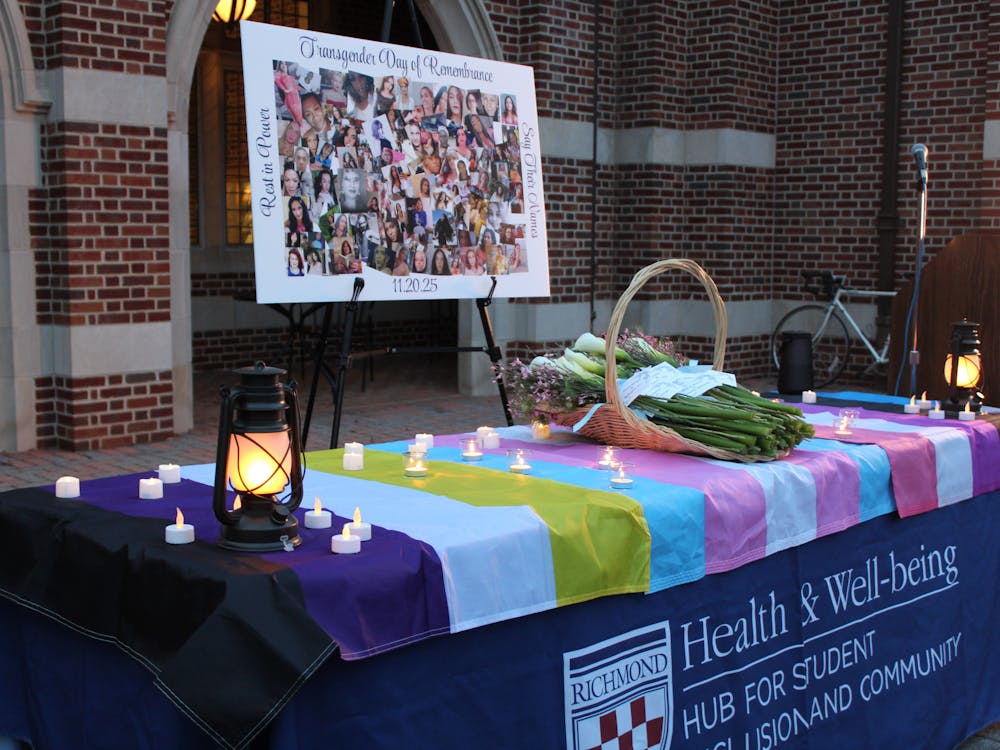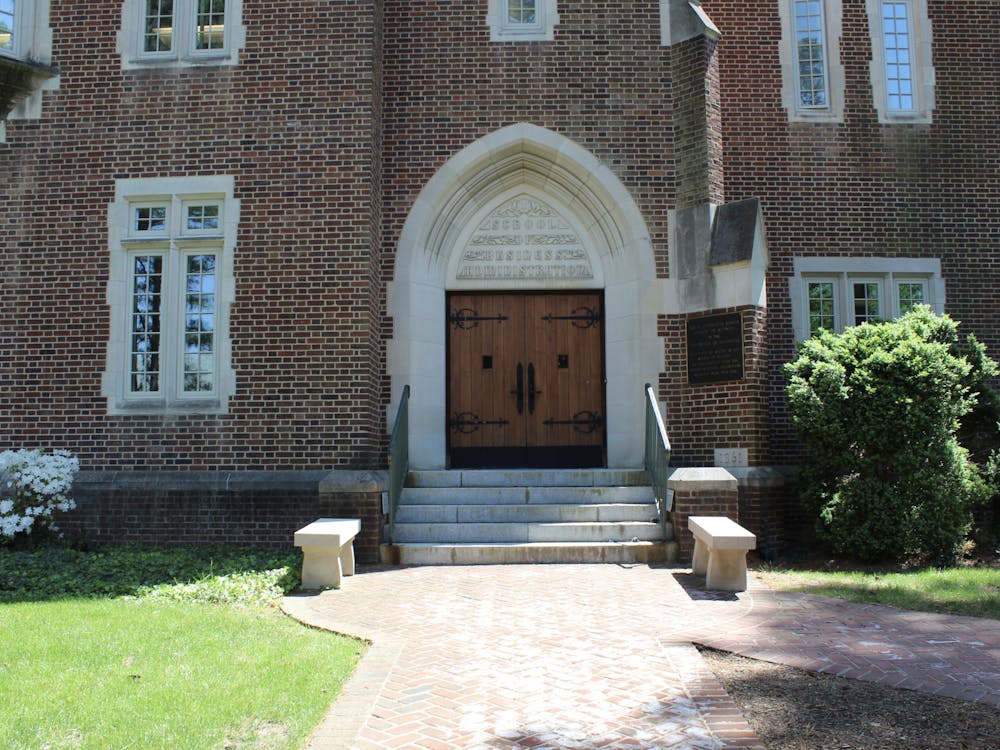Although many students' Halloween costumes elicited laughter this past weekend, one person's controversial choice ignited outrage and a flurry of discussion among the University of Richmond community.
Around 1 a.m. on Oct. 28, witnesses said a person was seen walking around the 800 block of the University Forest Apartments wearing a painted black face, a dreadlock wig and large, painted pink lips. Those who saw the person said the costume reminded them of blackface, a style of theatrical makeup that was popular in the United States during the 1800s, and one that carries a strong tones of racism in today's society. It was not immediately clear whether the person wearing the painted face was a Richmond student.
Junior Daniel Harawa said he saw the blackface costume late Saturday night. After stepping outside of an apartment where he and others were celebrating a friend's 21st birthday, he said he saw the face-painted person walking by the apartment with some other students, presumably looking for a party.
"Is this really what I'm seeing?" Harawa said he asked himself.
Harawa asked the person to stop to talk to him, but the request was ignored, and he continued walking to the next row of apartments. Upon going back inside, Harawa said he didn't tell others at the party about what he had seen because he didn't want to upset other students.
Instead, he wrote a letter to the university administration on Sunday afternoon expressing his concerns about the situation. He said he hoped that by alerting everyone on campus about what had happened, actions would be taken and similar situations could be avoided in the future.
"I wanted all the leaders on campus to know because, as a community, all of the leaders need to be aware of what happened so we can deal with it collectively," Harawa said at this week's Multicultural Student Union meeting.
Some students heard of the situation through word of mouth during the early part of the week, and President Edward Ayers addressed the issue in a university-wide e-mail on Tuesday afternoon. In the e-mail, Ayers said such behavior "has no place on this campus."
"I think it's possible that some students do not understand just how deeply offensive this practice is," Ayers said in an e-mail interview following the announcement. "And it's offensive whether it was intended to give offense or if no thought was given to its implications.
"Unfortunately, such incidents have been all too common at campuses across the country. I wanted to send a clear signal that such acts have no place here."
Harawa said: "I've been impressed with the campus reaction so far. The fact that President Ayers has said something about the situation and not merely skimmed over it says a lot about him and his presidency."
Harawa said the Richmond College and Westhampton College dean's offices, student governments and other student groups have also been proactive in making it clear that such behavior would not be tolerated on campus.
Enjoy what you're reading?
Signup for our newsletter
Harawa said though there have been other minor incidents at Richmond in the past that had made him feel unwelcome, he had never experienced anything as blatantly offensive as this weekend's incident.
Glyn Hughes, director of Common Ground, said there were a handful of situations that seem overtly racist every year, and attention is focused on them because society likes to think it has gotten past these racial problems. He referenced recent noose-related incidents at the University of Maryland at College Park and the United States Merchant Marine Academy. Hughes attended a conference last summer in San Francisco called "Blackfacebook," which focused on the rising popularity of race-themed parties on college campuses and their relation to greater racial problems.
Common Ground has posted information on the history of blackface on its Web site and encourages students to discuss their views on the issue. In his essay "About Blackface," painter Michael Ray Charles gave a short history of the subject:
"Fueled by white male obsessions with defining African Americans as exotic and comically irrational fools, blackness was exploited for profit," he wrote. "Issues surrounding the initial use of blackface continue to mold contemporary fantasies and realities, as blackness remains a preferred choice of intrigue, amusement and exploitation."
Hughes said it was possible for a white person to dress in blackface and not be aware of its implications, though that does not necessarily make the person's behavior acceptable.
"I'm not sure ignorance is an excuse," he said. "But it is a possible partial explanation."
Many students agreed that a lack of knowledge about the history of the use of blackface was not enough to justify its use.
"I think he was unaware of the history of blackface," junior Yvonne Green said. "But even with this ignorance, you must know that impersonating another race is a highly sensitive issue."
Senior Jamilah LeCruise said: "A lot of people tried to defend him, saying that it was just a joke. They must not know their history."
But other students have said that the student wearing blackface could have done so without the intention of striking such a sensitive nerve. Senior Lana DelliCarpini said she and her friends were unfamiliar with the issue until they learned about its history earlier this week.
"I had no idea what blackface was until I read [Harawa's] letter," she said. "Only now does it have any significance to me."
DelliCarpini said there were other examples how students' cultural differences could alter their perceptions, pointing out that the original name of last weekend's senior social, "Senior Spook," had to be altered because the class cabinets were not originally aware that the term "spook" is regarded as a racial slur by some.
"This shows how archaic some of these terms are to our generation and that [the student wearing blackface] may not have known what he was doing," DelliCarpini said.
Whether students are familiar with the history of such controversial issues, Hughes said society must acknowledge the role of issues such as this and other campus incidents in the larger social perspective. Hughes said a key issue was finding the relationship between these seemingly isolated incidents and the broader societal issues of inequality, such as the racial gaps in wealth, education, incarceration rates and access to health care.
"These incidents are symptoms of underlying ideas that white people have toward people of color," he said. "But these symptoms don't explain those gaps."
Ayers stressed the need for students to think about the repercussions of their actions before they do them.
"Many people do things not thinking -- or caring -- what their actions may mean to other people," he said. "One reason people come to college is to have their eyes opened to the larger meanings and deeper implications of what they do and don't do."
Though the incident seemed to only target a certain group of students, Green said the situation was relevant to everyone on campus.
"It affects all of us, not just the black community," Green said.
Support independent student media
You can make a tax-deductible donation by clicking the button below, which takes you to our secure PayPal account. The page is set up to receive contributions in whatever amount you designate. We look forward to using the money we raise to further our mission of providing honest and accurate information to students, faculty, staff, alumni and others in the general public.
Donate Now


